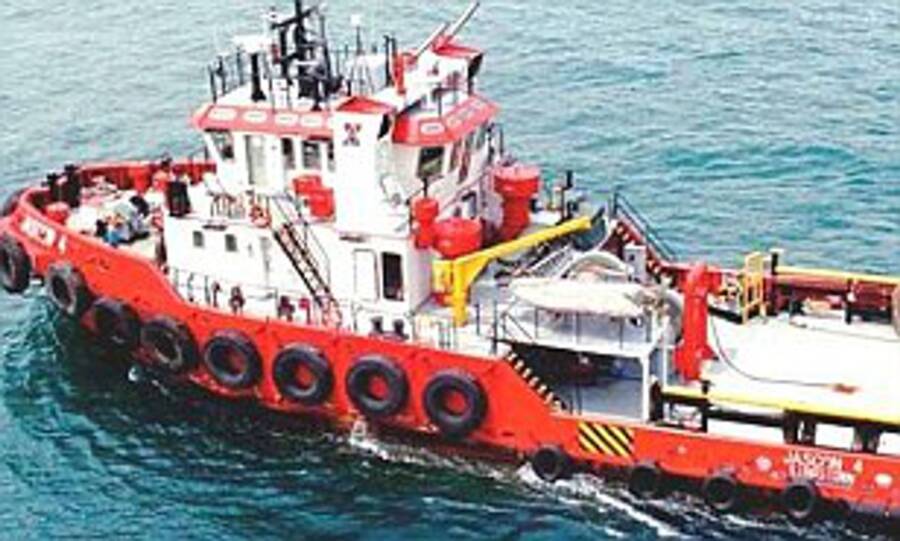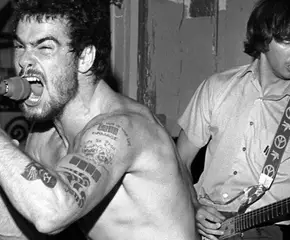Harrison Okene was working off the coast of Nigeria in May 2013 when a freak wave caused his tugboat to sink — trapping him 100 feet beneath the surface of the sea.

DCN Diving Group/Barcroft USAHarrison Okene, the moment he was discovered by divers.
When the Jascon-4 tugboat overturned off the Nigerian coast in May 2013, it made headlines around the world. Most assumed there were no survivors — until three days later, when the ship’s cook Harrison Okene was discovered by divers inside. Incredibly, Okene was alive, clinging to a makeshift raft in a small pocket of air in the overturned vessel.
The 29-year-old had endured what, to many, would be an absolute worst-case scenario. He was trapped almost 100 feet below the water’s surface, with a limited supply of oxygen as swarming crawfish tore at his skin.
Yet Okene survived. And, incredibly, the harrowing experience didn’t instill a fear of water in him. In fact, Okene went on to train as a professional diver.
This is the story of how Harrison Okene survived one of the most horrifying experiences imaginable — and learned to embrace his fear.
The Tragic Overturning Of The Jascon-4

West African VenturesThe Jascon-4 tugboat which overturned in May 2013.
On May 26, 2013, while performing towing operations to stabilize an oil tanker at a Chevron platform 20 miles from Escravos, Nigeria, the Jascon-4 encountered heavy ocean swells. After being hit by a massive wave, the tugboat flipped over and sank. Worldwide media reported the sinking, and speculation swirled about the the fate of its 12 crew members.
At the time of “the incident,” as Okene referred to it in a 2023 interview with The Guardian, he had been in the bathroom.
Harrison Okene was 29 years old at the time, and the crew’s cook. He’d woken up, said his prayers, and started to prepare for the day ahead. Still in nothing more than his boxers, he went into the bathroom and closed the door, thinking about his leave, which was set to start in three days.
Then, the wave hit — and water began to pour in.

AP/YouTubeAfter 60 hours, Okene likely experienced some symptoms of carbon dioxide toxicity.
The boat had flipped over, literally turning Okene’s world upside-down. His sense of direction gone, he ran out into the hallway to find his crew mates struggling to open an exit hatch. In that moment, he made a pivotal decision — one that may have seemed strange to most people.
He turned around and dove back into the water.
“I did not have the patience to wait,” he recalled. The water pulled him deeper into the vessel, to another bathroom attached to the second engineer’s cabin. The door shut behind him as water flooded in, but the room did not fill completely.
“The air couldn’t go out of the boat completely,” he said, explaining that the crew, ever vigilant for an attack from pirates, made sure to keep their cabin doors shut. “Some had to be trapped inside.”
In this upside-down room where the floor became the ceiling, a small pocket of air had formed — just enough for Okene to keep his head and chest above water. It was a small bit of hope. He wouldn’t drown in here, but he still needed to get back to the exit hatch.
But as he attempted to open the bathroom door, the handle broke. Harris Okene was trapped inside a boat 100 feet from the surface.
How Harrison Okene Survived For Three Days Underwater
Okene had no way to signal for help. The room he was in had an area of roughly four feet, and from the rest of the vessel he could hear “so many shouts, shouts, shouts” from the other members of the crew.
Most people would likely panic in this scenario, but Okene told himself, “instead of panicking, you have to think of a way out.”
He noticed a vent in the room with him and broke it, using its steel to pry open the bathroom door. By now, the vessel was full of water, but in the second engineer’s cabin he found two lifejackets and two flashlights with them. Okene could no longer hear his crew mates calling out and assumed, optimistically, that they had managed to make it out alive.
Tragically, he would later learn that everyone else onboard perished.
“If you got stuck in any room, you were lost,” he said. “It was totally dark, I was confused. If you don’t act fast, you can lose your life there.”

Harrison OkeneOkene with the divers who found him 100 feet underwater.
In his quick thinking, Okene managed to find some loose coveralls, a can of cola, and a tin of sardines by rifling through some bags. He fashioned a makeshift rope out of torn-up bits of the coveralls to help him find his way back to that air pocket, and over the next three days he would make frequent trips into the cold, dark waters of the drowned vessel in search of escape, returning each time to the small bit of safety he had.
Eventually, though, Harrison Okene decided to stay put. He had not been able to find a way out, and the salt water he had swallowed had hurt his tongue and his throat. He made a decision to hunker down in his air pocket and pray that, somehow, he would make it out alive. Meanwhile, crawfish began to pick away at his skin.
That oxygen wouldn’t last forever, though. And even if it did last for the next couple of days, Okene’s time was running out for another reason.
Speaking with National Geographic a few months after the incident, Eric Hexdall, a nurse and clinical director of diving medicine at the Duke Center for Hyperbaric Medicine and Environmental Physiology, estimated that a person in Okene’s situation would have had roughly 56 hours before carbon dioxide toxicity set in.
“If you’re trapped in something like that, your carbon dioxide levels will build to a toxic level before you use up the oxygen,” Hexdall said. Okene’s breath in that limited space would create a toxic amount of carbon dioxide quickly, and the extra carbon dioxide in the water would only speed up that process.
Okene had, in fact, likely begun to experience some of the first symptoms of carbon dioxide toxicity after those first 56 hours. After 79 hours, Hexdall estimated, he would have fallen unconscious.
But by some miracle, 60 hours after Harrison Okene became trapped in the air pocket, his prayers were answered.
The Dramatic Rescue Of Harrison Okene And His Life In The Aftermath
In a video shared by the Associated Press after Okene’s rescue, divers captured the moment they found him. They had come to try and recover bodies, not expecting to find Okene alive 100 feet below the surface.
Yet, there he was.
Okene, disoriented from the dark, reached out to grab one diver’s hand, but they couldn’t bring him straight to the surface. The pressure would wreak havoc on his body. The divers gave him more oxygen, then took him to their bell where they kept him in a recompression chamber for another three days. Finally, after nearly a week, Okene returned to the surface — and despite the harrowing circumstances, his vital signs were completely normal.
“Everything was normal,” he remarked to The Guardian. “My temperature, blood pressure. I thought, that’s not normal.”
Indeed, there was something incredible about Harrison Okene. A year after the sinking of the Jascon-4, he survived yet another harrowing accident when his car plunged over the edge of a bridge and into the water below.
Okene freed himself and came up to the surface, only to realize his friend was still in the sinking car. “What are you afraid of?” he asked himself. “How can you be scared? You have seen so much. If you have come through this, I think you should not be afraid of anything.” Mustering up his strength, he dove back into the water and rescued his friend.
After separating from his wife in 2015, Okene found himself depressed and adrift. But he found salvation in a surprising place. Despite pushback from his brother, he began training as a diver.
“I was alone. I didn’t have children, I didn’t have a wife. Not a good job. I was frustrated. Just alone with my dog. I was depressed, but nobody knew,” he said.

Harrison OkeneHarrison Okene at 39, working as a diver.
The ocean still called to him, and he ultimately completed his training and started working as a diver, installing, constructing, and repairing oil and gas facilities out on the ocean. In the end, Harrison Okene’s survival reinforced his faith, both in a higher power and in his own abilities. But more than anything else, his story is one of embracing fear and overcoming extraordinary odds.
“I have faced a lot of my fears in my life, and I decided to face this once and for all,” he reflected. “I know it should be my fear, but I don’t need to be scared of water. Because I need to embrace my fear once and for all and be strong. Our happiness, our joy, our future – they are all in our hands. I had to reprogramme my thinking. I balanced my mind.”
After reading about Harrison Okene’s miraculous survival, read about 11 other captivating survival stories from around the world. Then, read about nine fascinating stories of survival and third man syndrome.





